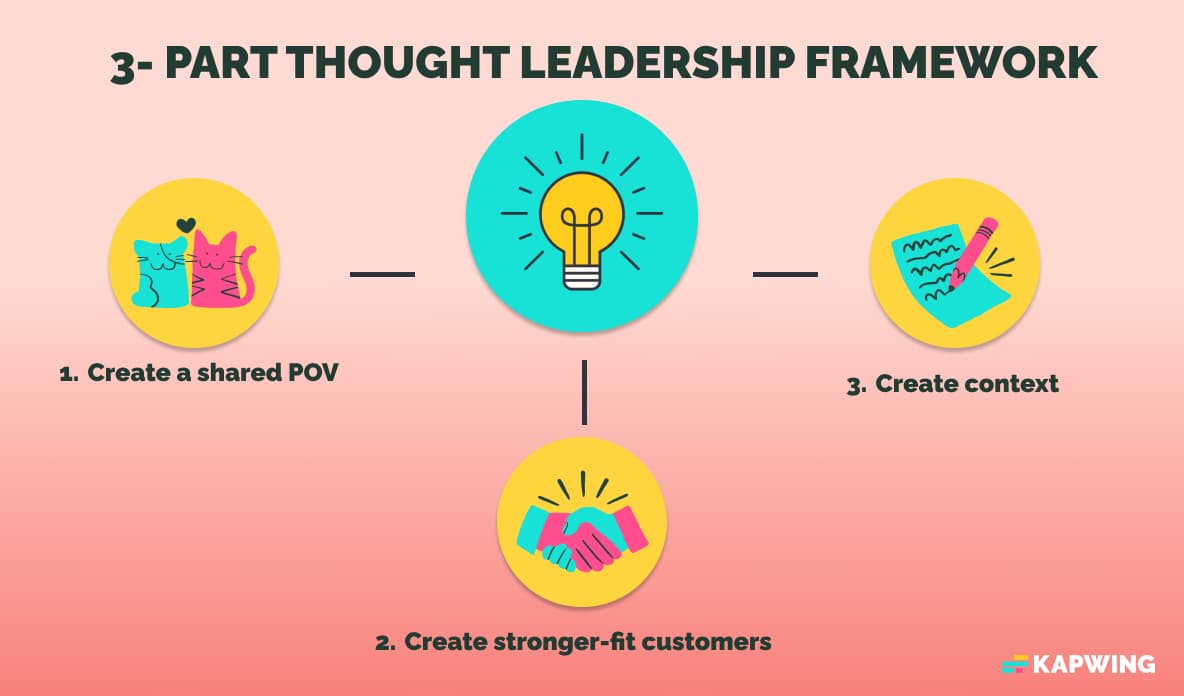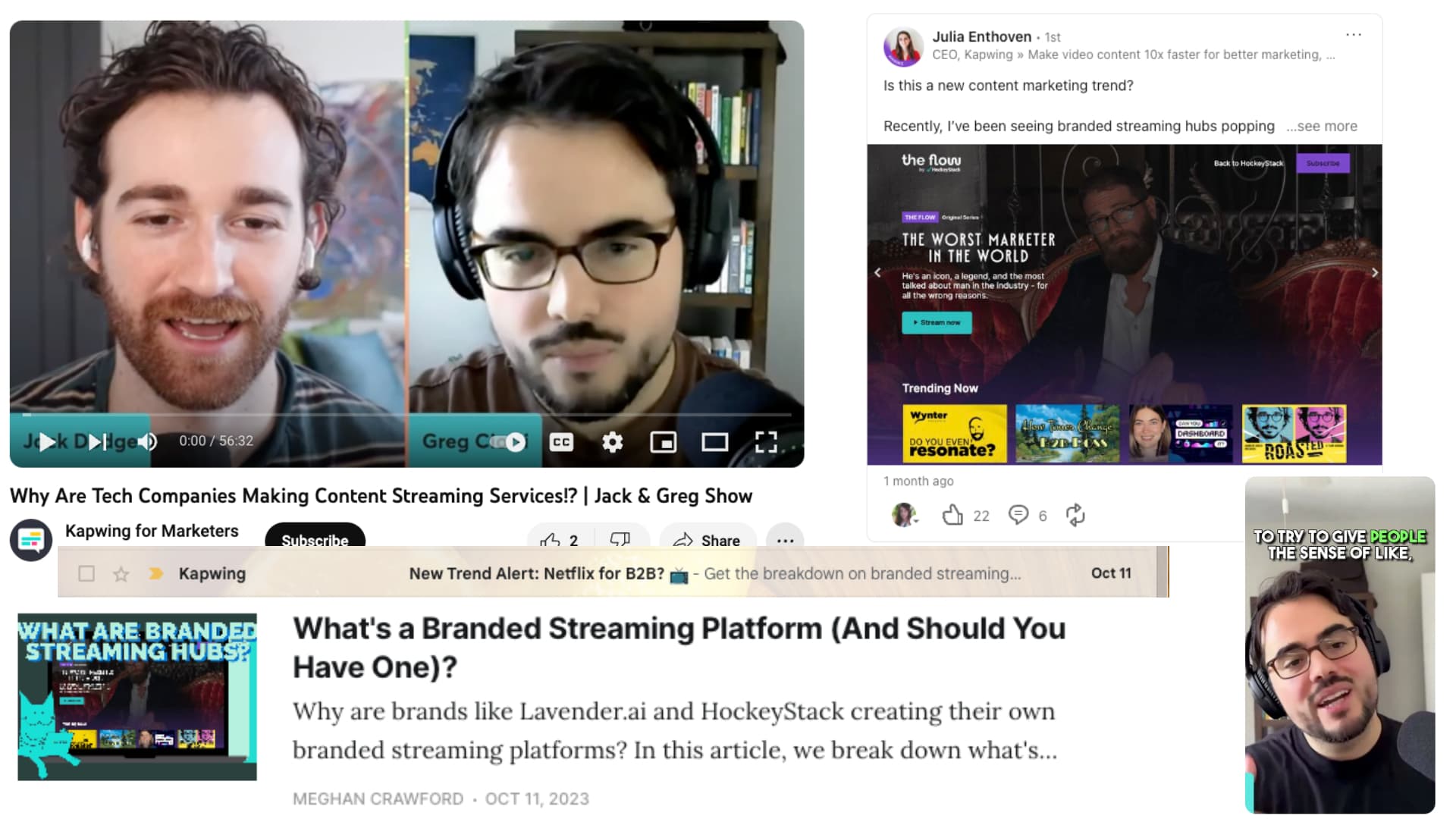How to Grow Your Business with Thought Leadership
Thought leadership gets a bit of a bad rap, but done correctly, it can earn better-fit customers for your business and increase retention rates. Today, we break down how with our 3-part thought leadership framework.

Thought leadership is often pitched as a cure-all tonic to every content marketing woe.
Influencing your customers toward the right outcomes is obviously an important part of marketing, but most thought leadership is more concerned with being flashy and impressive than it is with being convincing. Or, if it is convincing, it might convince prospects of things that just don’t matter in the end—at least not for the company that spent the time and money producing the content.
Hot takes are great, but only if they actually serve a purpose.
In this article, we’ll take a look at how you can avoid these traps and approach thought leadership in a simple, direct way that will actually help grow your business (not just your LinkedIn following).
First, though, what is thought leadership?
Watch our podcast episode to get the full scoop ☝️
We're not talking about 50-slide carousels on LinkedIn that over promise and under deliver.
Instead, think of thought leadership as content that tries to influence people to change their behavior in a way that benefits them, yes, but that is also good for your business. Thought leadership content can vary in terms of production quality, execution, and medium, but the high level goal should always be the same.
You’re convincing your prospects and customers of your company’s unique point of view, often by leveraging experts within your organization or industry to lend authority to the message. If done correctly, you’ve primed your audience to be better customers, with higher conversion and retention rates.
What does most thought leadership get wrong
One of the most common mistakes we see in thought leadership programs is that they fail to consider their end user, the customer, when developing the topics and themes they want to speak on.
It’s not just about demonstrating expertise on some topics you feel strongly about. At least, for brands it’s not. That might be successful for entrepreneurs with personal brands who plan to monetize with courses or coaching down the line. But for companies, it all begins with the customer.
Our framework for better thought leadership content

The “goal” of all thought leadership content should start by assuming success.
Let's assume a prospect does stick around and listen to all (or most) of what you have to say. What should change from before they started, to after?
To help you answer that question, we recommend following this three-part framework.
1. Create a shared point of view
Exposure to thought leadership content should create a shared point of view between you and your audience.
Over time, customers or prospects who are reading or watching what you produce should share your beliefs about email marketing, project management, password security, or whatever it is that you’re creating content about.
Perhaps they see it first through a blog post, then a video series, then a weekly thread of LinkedIn posts from your founder. With this change in belief should come a change in behavior.
Here at Kapwing, for example, we believe very deeply in the importance of video as a driving factor for content strategy. So, we produce content that aligns with that belief and explains why we’re so convicted. Then, we atomize that content so that it appears everywhere that we have an online presence: our company blog, our YouTube channels, our social media accounts, email marketing, even on our founder’s personal social accounts.
As an example, take a look at all of the different pieces of thought leadership content we produced on the single topic of branded streaming platforms:

Of course, we can’t say that we’re successful until we see behavior changes – marketing professionals pitching video strategies for the first time, more video podcasts popping up on our feeds, more people considering using video as their anchor medium. But that’s true for any thought leadership program.
Which leads us to the second goal of our thought leadership framework.
2. Create stronger-fit customers for your product
If you can affect a change in people's beliefs and behavior, you are making them better prospects for your business.
Kathy Sierra talks about this in her book Badass: Making Users Awesome. It’s always easier to sell a product to a customer who’s already bought the problem. They should believe that there’s some opportunity that they don’t have yet.
Good thought leadership is about getting users to that point. Then your product will start to look like the obvious solution.
3. Create context around the problem and solution
Finally, thought leadership should provide context for your prospects.
It’s hard to care about an isolated problem without seeing the bigger picture of how it fits into the current industry landscape. Give users a sense of the stakes and an understanding of where things are headed and why that matters. Give them evidence so that they know they’re not just getting marketing messages from a company with an agenda and a biased point of view.
Data is an excellent tool for providing this sort of context and proof.
If your audience is asking, “ok, but why should I care?” after engaging with your thought leadership content, there’s not enough context.
Thought leadership with commercial intent must persuade the reader in such a way that it either makes profitable customer action come easier or more fruitful. Otherwise, you might impress and influence people but create no connection to your product.
And that's the job of marketing: to connect customers with products.
So, now that you have this framework to start from, it’s time to decide what to talk about, aka choose your thought leadership narrative(s).
How to pick thought leadership narratives
Firstly, marketing narratives need to either start with or get buy-in all the way up. Marketing must tie-back to the product you're actually building, so all of these pointed thoughts mean little if they aren't reflected in the product.
When developing thought leadership topics and themes to come back to, there are three areas to look at:
1. What's changing:
- What changes are happening in the space/market?
- What old approach is losing its luster?
- What are new or nascent concepts sprouting up?
2. What's wrong:
- What's a best practice that's anything but?
- What's a frequently misunderstood (but important) concept or strategy?
- Where are people causing themselves undue misery?
3. What's the idea/future look like:
- Once we apply the "new way," what's better?
- What will we never go back to?
If your thought leadership addresses these questions and ties the answers back to your product, you’re on the right track. Remember, though, the third pillar of the thought leadership framework is to create context.
Avoid publishing hot takes in a vacuum by mapping all of your points to:
- Evidence that proves these things are true (data, examples, personal experience)
- Evidence your product meets these changes (better than the competition)
Remain open to customer and prospect feedback
Sometimes, even our most educated guesses as marketers fall short of the mark.
So, trust your instincts when developing your topics and themes, but stay open to customer and prospect feedback, too. A modified OODA loop works well for defining thought leadership narratives:
- Observe: Look at what's happening in your product's industry/vertical.
- Orient: Form your points of view based on what you see.
- Act: Create your narratives and test content ideas.
- Assess: Listen to both current customers and incoming prospects for feedback.
By keeping your customer at the center of your thought leadership program and supporting your claims with evidence and proof, you’ll be able to build strong, well-supported narratives.
The era of LinkedIn threads full of hot takes that are actually lukewarm is (hopefully) behind us. Thought leadership that actually earns customers is compelling, convincing, and customer-focused.









